Search results
3 results found.
3 results found.
They go on all year, all over Italy, but for some reason it’s only in the autumn that I give any thought to the innumerable festivals dedicated to food. Or food products, or plants or animals, or anything peptic or nutritious.
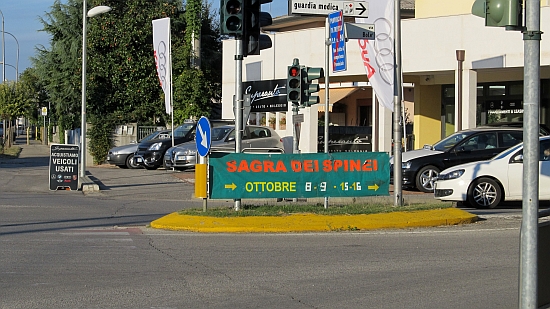
The keyword is sagra, which the dictionary defines as “feast,” “festival,” or “religious festival,” because the local product being celebrated is sometimes linked to the local patron saint. Not required, though. It’s more the local product that is worshiped and glorified. Anyway, the public tends to respond more quickly to the phrases “gastronomic stands” and “typical products” than to “religious procession and Mass,” and these events are usually aimed at the paying visitor, not the quaint locals who in days of yore would have been the only participants.
Rummaging through assorted calendars for something fun and comestible to celebrate this month in the Veneto , I discovered that in October there are sagre devoted to chestnuts, pumpkins, cheese, grapes, jujubes (known in Venetian as zizoe), honey, wine, baccala’, black truffles, ducks, walnuts, apples, eels, and the gnocco (plural gnocchi, since you tend not to eat just one). This one is tempting, as “gnocco” is also slang for “dullard,” “poltroon,” “dimwit,” which I think is funny, though I assume the organizers are not referring to the people they want to attract.
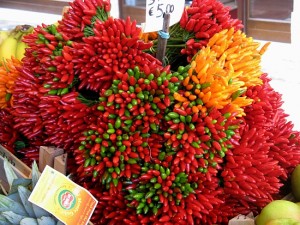
I see that “Automotive Dealer Day” sneaked its way onto the list for the area around Verona. Hard to think of what would be good to eat here, though I guess 40W oil might be useful for frying. Maybe this is one event in which food isn’t involved, hard as that may be to imagine. Unless they are cleverly referring to the automotive dealer as the edible item.
The few sagre I’ve been to tend to follow a simple pattern: Pick a local product you wish to festivize; get lots of it; organize it on stands or in halls, possibly with demonstrations of its cultivation, history, industrial management, recipes, or whatever other features seem important; cook lots of it in various ways to sell at inflated prices; add some extra events, such as demonstrations of historic skills (how to make cheese or spin wool or other things the old-fashioned way is popular); perhaps add some race or competitive event; publicize, provide parking (this one is optional), make money.
Oh — and make sure you hold your event in a picturesque little place that is almost (or better, completely) unreachable by public transport. Trains? Buses? Of course they exist, except on Sunday, when often they do not. Then you get off at the nearest station and try to find a taxi or, as happened last year, you walk. We did eight miles. Lino has made it clear that we are not going to repeat this exploit.
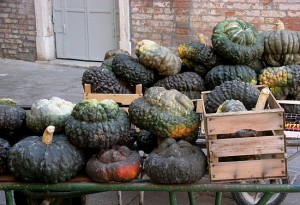
The problem is that any sagra reasonably near home base isn’t very appealing. You need distance, even a frustrating distance, to create the necessary allure. Because — let’s be honest — spending the day wandering among pumpkins or grapes doesn’t have a lot more intrinsic appeal than spending the day in the produce department of the supermarket. Spending the day among gnocchi — why travel? As soon as you walk out the door here, you’re surrounded by them. So to speak.
I spent two days trying to organize the logistics to go to Arqua’ Petrarca, which devotes two consecutive Sundays to its local star, the zizoe. In fact, I had my heart set on it. This is always a bad move, because disappointment is usually right behind. I discovered that while a train does go to the nearest town, Monselice, there are two choices for traveling the four miles (six kilometers) to Arqua’ Petrarca. The first was by taxi — there is one taxi in Monselice — and the driver wanted 20 euros ($27) each way. You see that it’s not only in Venice where they flay your wallet alive. Or the bus. I checked, not without some difficulty, with the bus company, and guess what? They don’t run on Sunday.
I myself would seriously considering getting a folding bicycle , which would be easy to carry on the train, but Lino didn’t want to hear about it. He may have sensed I was edging too close to committing an Americanata.
I forgot to mention that for us to arrive at a sagra at a reasonable hour (say, 9:00 AM, when it might be opening), it means getting up at 4:00. Because to be at the train station by 6:00 or so means there is only one vaporetto running — sorry, I meant crawling. So if I’m prepared to get up in the middle of the night like some shift worker in a Christmas-ornament factory, the sagroids — or however the organizers are called — ought to make some provision for me.
Sending a limousine would be acceptable.
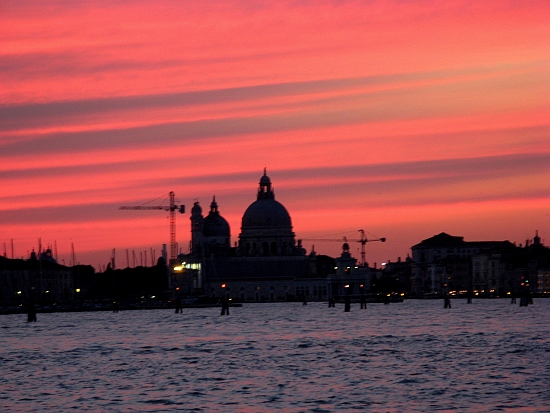
By which I don’t mean the financial market, and “today” is generally intended to mean more-or-less now. I’m referring to what new edibles are on sale in the market these days.
As I may have mentioned elsewhere, one of the many ways in which I notice the seasons changing is by what arrives and departs from the fruit and vegetable stands. (Fish also. Meat pretty much stays the same.)
I should note that in the past few years the rot of nonlocal-feedlot-hothouse-raised-out-of-season comestibles has begun to set in. I used to love the fact that you really could stick with the seasonal offerings here — in fact, you hardly had a choice.
Now there are strawberries in January and cherries in September and artichokes virtually all the time. It’s grotesque, and not only because of the prices. That there is a market for them is what’s distressing. Happily, a few items such as fresh peas and cardoons and loquats and parsnips have eluded the commercial drift-net so far, that mechanism that sweeps products indiscriminately off the calendar and dumps them all onto the shelves and into the bins together.

So what makes my heart leap up when I see plants take their cues and slip onto the autumnal culinary stage here? Walnuts — Italian, as well as from California.
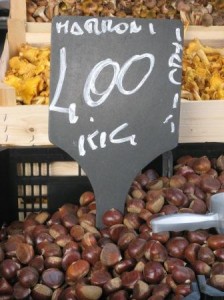
Chestnuts from various parts of northern Italy, the most prized being from Piedmont, around the town of Cuneo. “Zucca barucca,” a pumpkin which if you didn’t know it was so good you’d think was a sort of mutated Hobbit. Cachi (KA-kee), or persimmons. The leafless branches of trees in gardens here are festooned with these golden spheres far into the fall, little grace-notes of sun in a season which becomes progressively grayer. If I were a canning-and-preserving person, I’d be working around the clock.
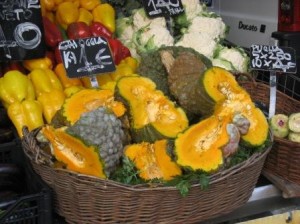

Best of all, the giuggiole (JOO-joe-leh). It’s better in Venetian: zizoe (ZEE-zo-eh). In English: jujubes. You may think of jujubes only as that gummy candy you’d buy at the movies when you went for the Saturday-morning double feature. But they are a real fruit, perhaps a bit handicapped by the fact that they look like olives wishing they could be dates.
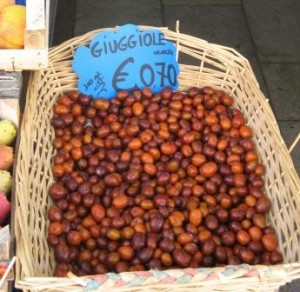 They have no juice — their main appeal is the crunch, and their unassuming flavor. And engaging as their Venetian name is (I buy some every year just so I can say “zizoe”) their scientific name is even better: Ziziphus zizyphus. Name of a man with a heavy head cold doomed to push a boulder uphill forever.
They have no juice — their main appeal is the crunch, and their unassuming flavor. And engaging as their Venetian name is (I buy some every year just so I can say “zizoe”) their scientific name is even better: Ziziphus zizyphus. Name of a man with a heavy head cold doomed to push a boulder uphill forever.
Modest though they may be, they have their own place in Italian culture. For example, there is an expression — “andare in brodo di giuggiole” (literally, “I went into jujube broth”) — which you would say when you wanted to convey extreme happiness or satisfaction. The “broth” is a sort of infusion/decoction which evidently is more delectable than you can imagine. Only now have I discovered a recipe for this beverage, or I’d have tried to make it before the zizoe disappeared and given a full report.
Around here the zizoe come mainly from the area of the Euganean Hills, beyond Padova, especially the environs of the hamlet of Arqua’ Petrarca, where Petrarch settled to live out his last days. The Arquites (or whatever the inhabitants are called — Arquatensi, actually) dedicate not one, but two Sundays in October to celebrating their yummy little drupe.
The Romans brought them from Syria; Herodotus noted that the wine you could make from jujubes would get you drunk in no time. (I’m freely translating.) There are recipes from the Egyptians and even Phoenicians.
Apart from its alcoholic potential, and the fact that it has more Vitamin C than the orange, it was especially valued by our forebears as being one of a group of so-called “chesty” fruits (such as figs, dates and grapes) which produced a liquid which, when condensed, could combat chest colds and respiratory inflammation, of which there is no shortage in this climate.
Here’s a recipe, which I’m already poised to try. All I have to do is wait till the end of next September.
BRODO DI GIUGGIOLE
I’ll see you next year with this one. It will be the Great Zizoe Broth-off.
 April 25 is the feast day of Venice’s patron saint, Mark. (Not the official patron saint of tourists, though you might have thought so. I haven’t been able to find one yet, though Gerasimos and Dymphna would be likely candidates, seeing that they’ve already been assigned to watch over the mentally infirm. Travelers — as opposed to tourists — have the choice of Nicholas, Joseph, St. Anthony of Padua (he of the lost-objects fame) and/or the Archangel Raphael. There is a definite difference between travelers and tourists, and it’s more often the latter who have need of divine aid. Those are just my thoughts.) Still, having one of the four Evangelists to watch over you ought to cover just about any eventuality, and clearly the early Venetians thought so too.
April 25 is the feast day of Venice’s patron saint, Mark. (Not the official patron saint of tourists, though you might have thought so. I haven’t been able to find one yet, though Gerasimos and Dymphna would be likely candidates, seeing that they’ve already been assigned to watch over the mentally infirm. Travelers — as opposed to tourists — have the choice of Nicholas, Joseph, St. Anthony of Padua (he of the lost-objects fame) and/or the Archangel Raphael. There is a definite difference between travelers and tourists, and it’s more often the latter who have need of divine aid. Those are just my thoughts.) Still, having one of the four Evangelists to watch over you ought to cover just about any eventuality, and clearly the early Venetians thought so too.
Venice was never without a patron saint, but for the first several centuries of its existence that task was assigned to a Greek soldier saint, Theodore of Amasea (“Todaro,” in Venetian).

In that era Venice was still technically a colony of Byzantium, and a saint’s being Latin or Greek had as much political as religious significance. By 828, though, Venice had begun to reach a level of importance, and independence, which convinced its rulers that they needed to upgrade their guardian. A Latin saint now looked better than a Greek one, and why stop there? They aimed for one of the four Evangelists, Saint Mark, whose body was known to repose in Alexandria, Egypt.
And so they went and stole him. Two intrepid sailors, known to history as “Buono” of Malamocco and “Rustico” from Torcello (unquestionably noms de guerre), spirited the body of the city’s erstwhile bishop out of the Muslim metropolis by hiding it on a wagon covered in pig carcasses (and also cabbage leaves, which was the Venetian way of conserving meat, between alternating layers of lard and cabbage. The Bible compares humans to grass, but Venetians are more realistic).
This exploit highlights two of the most fundamental Venetian traits: shrewdness and audacity. And in case “Good” and “Rustic” appear to have been improbably daring and clever, some scholars have made a good case for their having bribed the shrine’s guardian. The point here, as in much of Venetian history, is that it worked. For my money, the appropriate motto for the Old Ones wouldn’t be the legendary “Pax tibi, Marce, evangelista meus” [Peace to you, Mark, my evangelist] which is inscribed on the book most of his symbolic winged lions are holding, but a straightforward “Get it done.”
In the great days, Venice observed not one, but four celebrations of its saint:
All this wasn’t just because Mark deserved it. Venice’s masters loved pomp not only for itself but because they knew how to exploit it. They made a point of creating celebrations around an enormous number of events — saints’ days, deliverance from plagues (twice), military victories, even military defeats. All that was necessary was that Venice had to have been the star. It worked extremely well, because all of this festivizing kept civic pride bubbling away, ready for use at any moment. You weren’t even to imagine that there could be anything better than being a Venetian, and ceremonial was a dependable way to keep that fact front and center in your average Venetian’s brain.
Back to the body. There is a body under the high altar, and it is labeled as being Mark’s. Lino doesn’t believe it. I don’t know if this counts as heresy, but being a good Venetian, he doesn’t care. He makes a good case: For one thing, he says, it’s pretty suspicious that the body is never venerated, not even on April 25. For another, he says that when Angelo Roncalli (patriarch of Venice from 1953-1958) became Pope John XXIII, he gave an important (unidentified) relic to the church in Alexandria. Lino tells me this with that “What more do I need to say” look.
What it all comes down to today is the long-stemmed red rose, the longer and redder the better.
The custom is for a man to give one to the woman — or women — he loves. Could be his wife, mother, sister, girlfriend, cousin. No protocol on this, except for the wife or girlfriend, which are non-negotiable. Anyway, as roses were costing at least five euros each this year, the typical man’s list has probably been cut back to the minimum.
Lino is a traditionalist to the bone, or in this case, the rose. He would go without lunch and possibly even without wine, if he had to, but he would never skip the rose.
He even gives a rose to our club’s eight-oar gondola, or gondolone. Of course she is named “San Marco.”